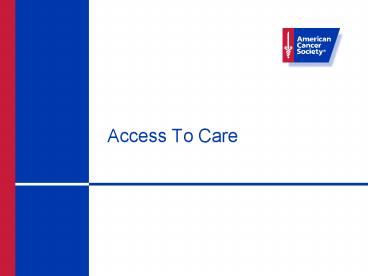Access To Care - PowerPoint PPT Presentation
1 / 20
Title:
Access To Care
Description:
... for late stage breast cancer. 50% for late ... National Breast and Cervical Cancer Early Detection Program ... Medicaid expansion, Emergency Medicaid. Summary ... – PowerPoint PPT presentation
Number of Views:72
Avg rating:3.0/5.0
Title: Access To Care
1
Access To Care
2
NO ONE DESERVES TO GET CANCER,
BUT EVERYONE DESERVES THE RIGHT TO
FIGHT IT.
There are 47 million uninsured people in America,
and countless others with insurance that doesnt
cover a disease as devastating as cancer. Were
making progress, but its not enough if people
arent getting care that could save their lives.
cancer. org
800.ACS.2345
FIND OUT WHAT WE RE DOING AND HOW YOU CAN HELP
AT cancer.org .
3
Why We Need to Take Action
2015 Goals Reduce Mortality by 50 Percent
4
Our Vision
- By 2015, everyone will have timely access to the
full range of affordable evidence-based
healthcare necessary to optimize health and
well-being.
5
Why Action is Needed
- 46 million Americans are uninsured
- Nearly 1 in 8 cancer patients is uninsured, and 1
in 4 cancer patients below 200 of the poverty
line is uninsured - Many more of those with cancer have inadequate
health plans that may not cover screenings,
treatments, and clinical trials
6
The Way Forward
- Frame the Issue and Educate
- Strengthen the Science
- Evaluate and Influence Policy Options
- Expand Partnerships and Collaborations
- Train and Mobilize Grassroots
- Continue Current Work
7
Why the Cancer Lens Cancer Treatment and the
Uninsured
- Uninsured women are 49 more likely to die than
insured women during the 4-7 yrs following an
initial breast cancer diagnosis - The uninsured are more likely than the insured to
have skipped medical treatments (39 vs. 13) or
not have filled prescriptions (30 vs. 12) due
to cost
8
Why the Cancer Lens Cancer Diagnosis and the
Uninsured
- The uninsured have an increased risk of
late-stage cancer diagnosis - 40 for late stage breast cancer
- 50 for late stage prostate cancer
- 70 for late stage colorectal cancer
- 150 for late stage melanoma
9
Why the Cancer Lens Cancer Screening and
the Uninsured
- NY NJ
- Breast Cancer
- Mammogram - women age 40 58.9
60.2 - 40-64 years old uninsured 34.8
35.7 - Cervical Cancer
- Pap test within last 3 yrs age 18
85.3 84.3 - 18-64 years old uninsured 76.2
77.2 - Colonoscopy or Sigmoidoscopy
- Within last 5 yrs age 50 47.6
49.1 - 50-64 years old uninsured
19.7 26.8
10
Why The Cancer Lens Cancer gets and keeps
people's attention
Cancer is perceived as being the most important
health problem facing the American public today.
It is also perceived as being the most important
health problem Americans personally could face in
the future.
Base All adults, 18 and older (n901)
Source 2004 Roper Image Survey
11
Why the Cancer LensCancer creates financial
burdens
Percent who say each of the following happened to
them/their family member as a result of the
financial cost of dealing with cancer
Used up all or most of savings
Borrowed money from relatives
Contacted by a collection agency
Unable to pay for basic necessities like food,
heat, or housing
Sought the aid of charity or public assistance
Borrowed money/got a loan/another mortgage
Declared bankruptcy
Source USA Today/Kaiser Family
Foundation/Harvard School of Public Health Cancer
Survey (conducted August 1 September 14, 2006)
12
Evaluate Policy Options Principles for Progress
Adequate Available Affordable Administratively
simple
13
Our Role
- The Society will not submit or endorse specific
reform plan (national) - The Society will not support or endorse a
political candidate - Four principles will be used as evaluative tool
for federal and state reform proposals
14
Partnerships and Collaborations
- Continue traditional collaborations
- Expand work with AARP, AA, AHA
- ADA
- Work with State and Local coalition partners
- Unions, Immigrant groups, business
15
Continue Our Current Work
- Patient Navigator Program
- National Breast and Cervical Cancer Early
Detection Program - Colorectal Cancer Early Detection, Prevention,
and Treatment Act - State funded screening programs
- Medicaid expansion, Emergency Medicaid
16
17
(No Transcript)
18
Summary
- Winning the fight against cancer depends on
improving access to health care. - One in four families will use most or all of
their savings while dealing with cancer-related
costs. - Americans shouldnt have to choose between their
health and financial ruin. - The American Cancer Society is making great
strides against cancer through research,
education, and programming. But it will not
matter if cancer patients cannot access the
quality health care they need to fight the
disease. That is why we have made access to
health care a key organizational priority.
19
U.S. Presidential Election 2008 VOTER GUIDE
20
Thank You































